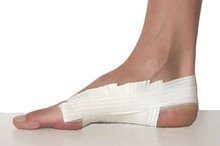What does fact checked mean?
At Healthfully, we strive to deliver objective content that is accurate and up-to-date. Our team periodically reviews articles in order to ensure content quality. The sources cited below consist of evidence from peer-reviewed journals, prominent medical organizations, academic associations, and government data.
The information contained on this site is for informational purposes only, and should not be used as a substitute for the advice of a professional health care provider. Please check with the appropriate physician regarding health questions and concerns. Although we strive to deliver accurate and up-to-date information, no guarantee to that effect is made.
Homemade Night Splint for Plantar Fasciitis
Plantar fasciitis is one of the most common causes of pain in the bottom of the foot. It is the inflammation of a band of tissue called the plantar fascia that connects the heel bone to the toes. Symptoms of plantar fasciitis include burning and throbbing at the arch of the foot or heel that is often worse first thing in the morning. As the tissue limbers up throughout the day, the pain should decrease some, and a night splint will help when you go to bed.
If you are experiencing serious medical symptoms, seek emergency treatment immediately.
Treatment
Plantar fasciitis is common in sports that involve running, dancing or jumping. It also presents in overweight persons, women who are pregnant, and those who wear shoes without adequate support for the arch.
To treat plantar fasciitis, stretch your plantar fascia by standing in front of a wall with your feet flat on the floor and your arms outstretched so that your hands touch the wall. Lean forward into a wall, putting more stress on the affected foot, until you feel a stretch in your Achilles tendon and calf. Massage the bottom of your foot to loosen the fascia. Roll your foot back and forth on a cold bottle of water to massage the foot and reduce inflammation at the same time, and sleep with a night splint. A night splint keeps the plantar fascia, Achilles tendon, and calf muscles in a gently stretched position so that the plantar fascia does not tighten overnight. Wear the night splint until your symptoms improve.
- Plantar fasciitis is common in sports that involve running, dancing or jumping.
- Lean forward into a wall, putting more stress on the affected foot, until you feel a stretch in your Achilles tendon and calf.
Homemade night splints
Foot Pain When First Walking in the Morning
Learn More
Night splints can be purchased, generally in a store that sells medical supplies, or can be made with common materials. Purchased splints are made from a variety of materials including elastic, Velcro, neoprene, cotton, fiber glass, or plastic. Homemade splints are made from these same materials.
Remember that the goal of a night splint is to place the foot in a flexed position until you feel a gentle stretch along the plantar fascia, by pulling the toes toward the knees. Wrap an elastic band or ace bandage around the foot and shin bone, in such a way to accomplish this. To further stretch the plantar fascia, and help the foot from pointing during the night, place a hard material against the bottom of the foot, before wrapping it with the elastic band or ace bandage. Hard materials include rigid over-the-counter inserts, or a thin piece of hard plastic or fiberglass that can be wrapped into the splint.
Try to make a homemade night splint from a long sock, like a tube sock. For example, take a tube sock and sew two loops on it, one on the sock around the middle of the shin, and the other, at the end of the sock where the toes go. Take a cord, shoestring or strip of cloth or elastic band and thread it through the loop down by the toes. Pull both ends of the band until you feel a stretch along the bottom of the foot, and then anchor it to the loop in the sock at the shin bone. If you prefer another method of securing the cord, use Velcro or some other type of fastener to construct the device.
- Night splints can be purchased, generally in a store that sells medical supplies, or can be made with common materials.
- To further stretch the plantar fascia, and help the foot from pointing during the night, place a hard material against the bottom of the foot, before wrapping it with the elastic band or ace bandage.
Prevention
Prevent plantar fasciitis by correcting any biomechanical issues, by stretching the Achilles tendon and calf muscles and by strengthening the arch through exercises like towel curls, marble pickups and toe taps.
Related Articles
References
- MayoClinic.com
- Schwartz EN, Su J. Plantar fasciitis: a concise review. Perm J. 2014;18(1):e105-7. doi:10.7812/TPP/13-113
- Sweeting D, Parish B, Hooper L, Chester R. The effectiveness of manual stretching in the treatment of plantar heel pain: a systematic review. J Foot Ankle Res. 2011;4:19. doi:10.1186/1757-1146-4-19
- Thing J, Maruthappu M, Rogers J. Diagnosis and management of plantar fasciitis in primary care. Br J Gen Pract. 2012;62(601):443-4. doi:10.3399/bjgp12X653769







